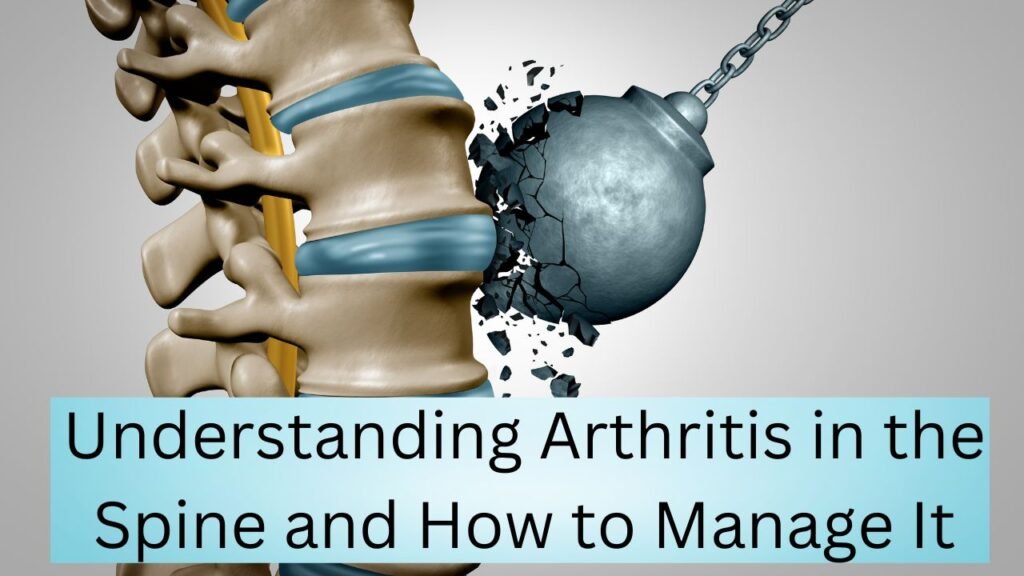Arthritis in the spine is a common condition that causes pain, stiffness, and reduced mobility. It occurs when the cartilage that cushions the joints in the spine wears down, leading to inflammation and discomfort. This condition is most prevalent in older adults but can also affect younger individuals due to injury or genetic factors. Understanding spinal arthritis and implementing effective management strategies can help improve quality of life.

What Is Spinal Arthritis?
Spinal arthritis, also known as osteoarthritis of the spine, is a degenerative condition that affects the facet joints, discs, and surrounding structures. Over time, the breakdown of cartilage leads to bone-on-bone contact, which causes pain and stiffness. In some cases, bone spurs may develop, further compressing nearby nerves and exacerbating symptoms.
Common Types of Spinal Arthritis
- Osteoarthritis (OA): The most prevalent form, caused by age-related wear and tear on the spine.
- Rheumatoid Arthritis (RA): An autoimmune disorder that leads to chronic inflammation and joint damage.
- Ankylosing Spondylitis: A type of inflammatory arthritis that primarily affects the spine and sacroiliac joints, potentially leading to spinal fusion.
- Psoriatic Arthritis: A condition associated with psoriasis that can cause joint pain and stiffness in the spine.
Causes and Risk Factors
Several factors contribute to the development of spinal arthritis, including:
- Aging: Natural degeneration of spinal joints over time.
- Genetics: A family history of arthritis increases the risk.
- Obesity: Excess weight places additional stress on the spine.
- Repetitive Strain: Jobs or activities that involve repetitive motions can accelerate joint wear.
- Previous Injuries: Trauma or fractures can lead to early-onset arthritis.
- Inflammatory Conditions: Autoimmune diseases like RA increase susceptibility.
Symptoms of Arthritis in the Spine
Spinal arthritis symptoms can vary based on the severity and location of the condition. Common signs include:
- Chronic back or neck pain that worsens with movement.
- Stiffness and reduced flexibility, especially in the morning.
- Tenderness around affected joints.
- Pain radiating to the arms or legs if nerves are compressed.
- Muscle weakness or numbness due to nerve involvement.
- Grinding or popping sensations when moving the spine.
- Limited range of motion, making daily activities difficult.
How to Diagnose Spinal Arthritis
A doctor may perform various tests to confirm the diagnosis:
- Physical Examination: Assessing movement, pain levels, and posture.
- X-rays: Detecting joint degeneration and bone spurs.
- MRI or CT Scans: Providing detailed images of soft tissues and nerves.
- Blood Tests: Identifying inflammatory markers for autoimmune conditions.
Best Ways to Manage Spinal Arthritis
Although spinal arthritis is not curable, several treatments can help alleviate symptoms and improve mobility.
1. Lifestyle Modifications
- Maintain a healthy weight to reduce strain on spinal joints.
- Practice good posture to minimize stress on the spine.
- Avoid prolonged sitting or standing by incorporating movement throughout the day.
2. Physical Therapy and Exercise
Regular movement strengthens muscles and enhances flexibility, reducing arthritis symptoms.
- Stretching exercises improve mobility and reduce stiffness.
- Strength training supports the spine and prevents further damage.
- Low-impact activities like swimming and cycling provide pain relief without excessive strain.
- Yoga and Pilates enhance posture and spinal alignment.
3. Medications for Pain Relief
Several medications help manage spinal arthritis symptoms:
- NSAIDs (Nonsteroidal Anti-Inflammatory Drugs): Reduce inflammation and pain.
- Acetaminophen: Provides mild pain relief for those who cannot take NSAIDs.
- Muscle relaxants: Alleviate muscle spasms associated with arthritis.
- Corticosteroids: Used for short-term relief of severe inflammation.
- Topical creams and gels: Offer localized pain relief with fewer systemic side effects.
4. Alternative and Complementary Therapies
Many individuals find relief through alternative treatments, such as:
- Chiropractic adjustments to improve spinal alignment.
- Acupuncture to stimulate pain-relieving pathways.
- Massage therapy to reduce muscle tension and improve circulation.
- Hot and cold therapy to manage inflammation and stiffness.
5. Assistive Devices and Supports
- Braces and supports help stabilize the spine and reduce pain.
- Orthopedic pillows and mattresses promote better sleep and spinal alignment.
- Walking aids like canes can help with mobility and weight distribution.
6. Injections and Advanced Medical Treatments
For individuals with severe pain, medical interventions may provide relief:
- Epidural steroid injections reduce inflammation and nerve irritation.
- Hyaluronic acid injections help lubricate affected joints.
- Nerve blocks temporarily disrupt pain signals.
7. Surgical Options for Severe Cases
If conservative treatments fail, surgery may be necessary:
- Spinal fusion stabilizes affected vertebrae to reduce pain.
- Laminectomy or decompression surgery removes bone spurs and relieves nerve pressure.
- Artificial disc replacement is an option for some patients with advanced disc degeneration.
Preventing Arthritis Progression
While arthritis is not entirely preventable, certain steps can slow its progression:
- Maintain an active lifestyle with regular exercise.
- Follow an anti-inflammatory diet rich in fruits, vegetables, and healthy fats.
- Stay hydrated to support joint lubrication.
- Avoid smoking and excessive alcohol consumption to prevent further joint damage.
- Use proper body mechanics when lifting objects to prevent spinal strain.
When to See a Doctor
Consult a healthcare professional if:
- Pain persists despite home remedies and medication.
- Numbness or weakness interferes with daily activities.
- Loss of bladder or bowel control occurs, which may indicate a serious condition.
- Mobility declines significantly, affecting the ability to perform basic tasks.
Conclusion
Spinal arthritis can significantly impact daily life, but effective management strategies can help reduce symptoms and maintain mobility. By incorporating lifestyle changes, physical therapy, medications, and advanced treatments, individuals can find relief and improve their spinal health. If symptoms worsen, seeking medical advice ensures appropriate care and long-term well-being.